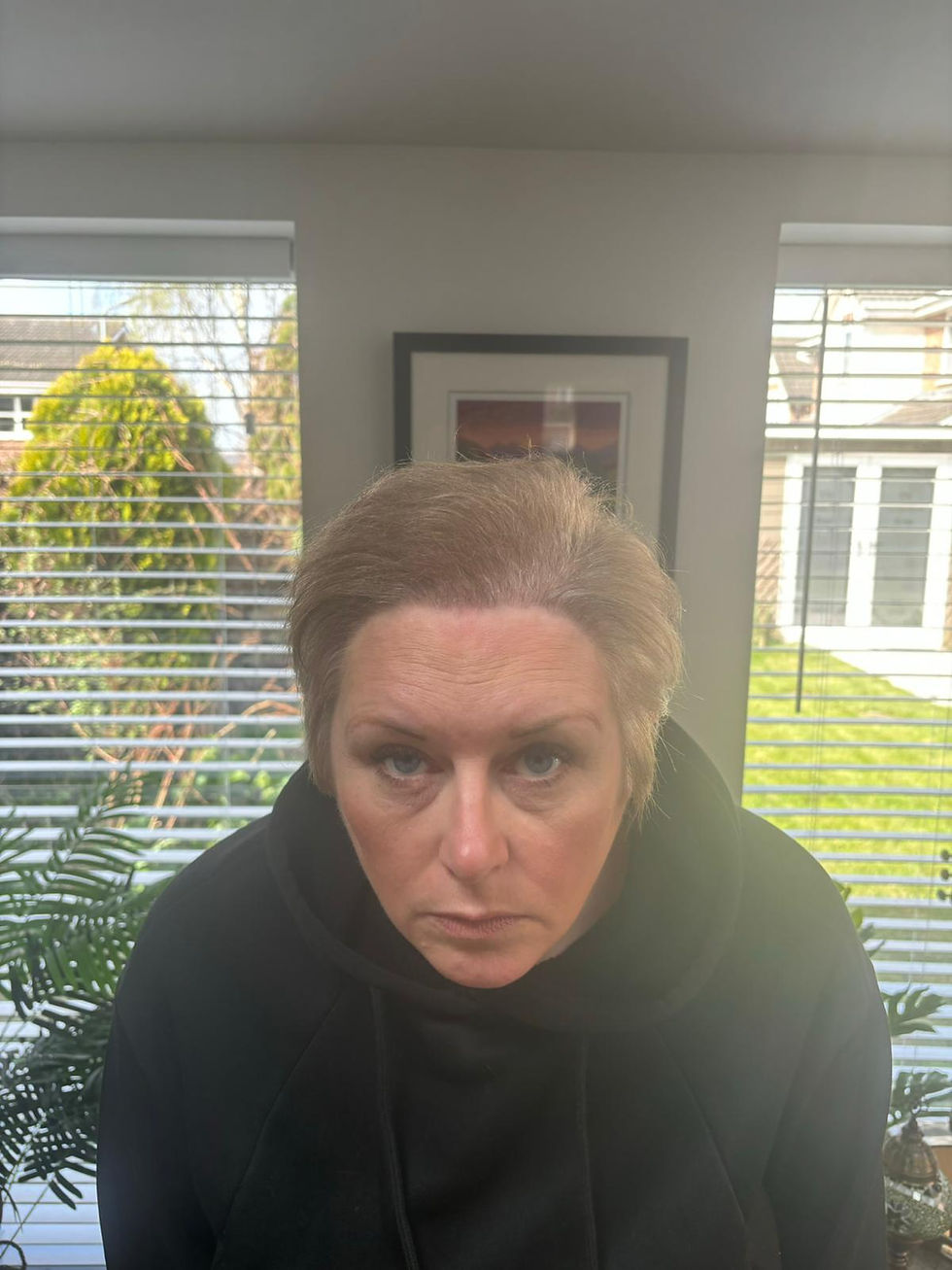What Are Scabs After Hair Transplant?
- Vita Hair Clinic

- Sep 4, 2025
- 6 min read

Getting a hair transplant is an exciting step towards restoring your natural hairline and confidence. During this procedure, small cuts are made to insert hair follicles into areas where hair is thinning or balding.
Scabs after hair transplant are a normal part of the healing process—these are small crusty patches that form on your scalp as it heals from the tiny wounds created during surgery.
Knowing what are scabs after hair transplant and their purpose in hair transplant healing is essential for your hair transplant surgery recovery. Taking proper care of these scabs helps protect new grafts, prevent infection, and support successful regrowth, making your journey smoother and more comfortable.
However, it's also important to be aware of potential hair transplant side effects, which can include unexpected changes in your hair growth pattern during the shock loss period after hair transplant.
This phase can be concerning, but understanding it as a normal part of the recovery process can help ease some anxiety.
For those considering a hair transplant, it's beneficial to seek guidance from experienced professionals. Dr. Kinyas Dusunmez, a renowned expert in this field, can provide valuable insights and support throughout your journey.
Scabs after a hair transplant are a natural part of the healing process. They form from dried blood cells and fibrous tissue created by tiny cuts made when transplanting hair follicles into the scalp. These small wounds trigger your body's response to protect the area.
The scabs serve two important functions:
Shielding the transplanted hair follicles from bacteria and external irritants
Securing the grafts in place as they begin to settle and grow
This protective barrier is essential, giving your scalp the time it needs to heal safely while supporting the success of your new hair growth.
If you have any concerns about your recovery process or the condition of your scalp post-transplant, it's important to consult with your healthcare provider. You can reach out to professionals for guidance and support through platforms like Vita Estetic, who specialize in such matters.
Appearance and Symptoms of Scabs Post-Transplant
When asking what do scabs look like after hair transplant, you’ll notice small, red, crusty spots forming around each transplanted follicle. These scabs can vary slightly in size but generally appear as tiny protective crusts.
Common symptoms of scabs include:
Tenderness: The scalp may feel sensitive to touch.
Itchiness: A mild to moderate urge to scratch is typical during healing.
Swelling: Slight puffiness around the grafted areas can occur.
Crustiness: The hardened texture of scabs helps shield the delicate new follicles.
Recognizing these signs helps you understand your scalp’s natural healing process while keeping an eye on what’s normal and manageable.
Timeline and Natural Progression of Scab Healing
Understanding the hair transplant recovery timeline helps you know what to expect during healing. Scabs typically start forming around the tiny incisions between 1 to 3 days after surgery. These scabs consist of dried blood and tissue, acting as a natural barrier to protect the delicate grafts.
The scab healing stages usually span about two weeks. During this time, the scabs gradually soften and fall off on their own, revealing healthy new hair growth underneath. Avoiding interference with this process is crucial for successful healing and graft survival.
Knowing what are scabs after hair transplant? means recognizing their role in your recovery and respecting their natural course.
Proper Post Hair Transplant Care to Manage Scabs
Caring for your scalp after a hair transplant plays a crucial role in how well the scabs heal and how successful your results will be.
Follow these key points for effective post hair transplant care:
Avoid picking or scratching the scabs. This prevents damage to the delicate grafts underneath and lowers the risk of infection.
Begin scalp washing after transplant gently with a mild shampoo about 2 to 3 days post-surgery. Use lukewarm water and softly pat rather than rub.
Keep your movements light and careful to help soften scabs naturally without dislodging newly implanted follicles.
This careful approach supports healthy healing, encouraging scabs to fall off naturally while protecting your new hair growth.
Precautions During Recovery to Protect Scabs
During your hair transplant recovery, taking simple precautions helps protect scabs and supports healing.
One key tip is avoiding irritation post-transplant by steering clear of hats or head coverings for at least the first week. Hats can rub against the delicate scabs, causing discomfort or even dislodging grafts.
Other helpful hair transplant recovery precautions include:
Keeping your scalp away from direct sunlight or extreme heat
Avoiding strenuous activities that cause excessive sweating
Sleeping with your head elevated to reduce swelling
These measures minimize irritation and create the best environment for scabs to naturally fall off without complications.
When to Seek Medical Attention Regarding Scabs
After a hair transplant, scabs are normal, but certain signs may indicate complications after hair transplant or infection.
Watch carefully for:
Excessive pain that worsens instead of improving
Uncontrolled bleeding from the transplanted area
Lumps or hard bumps under scabs which could signal deeper issues
Fever or chills, suggesting your body is fighting an infection
These signs of infection post-transplant require prompt medical evaluation to prevent damage to your grafts and ensure safe healing.
Knowing what are scabs after hair transplant helps you distinguish normal healing from symptoms needing professional care.
Hair Transplant in Turkey – Contextual Note on Aftercare and Healing
Turkey has become a leading destination for hair replacement, attracting thousands seeking affordable and high-quality hair transplant procedures. Clinics across the country offer advanced techniques with experienced surgeons, making hair transplant in Turkey a popular choice worldwide.
Post-transplant care in Turkey is emphasized as a critical factor for success. Regardless of where you have your procedure done, following proper aftercare guidelines is essential to ensure optimal healing and graft survival. This includes gentle scalp cleansing, avoiding irritation, and protecting scabs during the vulnerable early days of recovery.
To ensure optimal healing, it's crucial to follow expert hair transplant recovery and aftercare advice. These steps support the best possible outcome for your new hair growth journey.
However, it's important to be aware of potential hair transplant side effects and how to combat them. Understanding these challenges can help you navigate through the recovery process with strength and determination.
You might also wonder about the mechanics behind a hair transplant and where the hair comes from. This knowledge can provide you with a better understanding of the procedure you are undergoing.
Lastly, it's normal to have concerns about whether transplanted hairs fall after a hair transplant. Knowing more about the growth timeline and how to minimize shock loss can alleviate some of these worries.
Conclusion
Understanding what are scabs after hair transplant? helps you appreciate their role as a natural, protective response that supports graft survival.
These tiny crusts form to shield your healing scalp and secure new hair follicles during the delicate recovery phase.
Your focus should be on:
Practicing gentle care, avoiding picking or scratching
Following aftercare instructions with patience
Allowing scabs to fall off naturally within two weeks
This approach maximizes your chances for healthy healing and a successful hair transplant outcome. Remember, proper care is key to turning this temporary stage into long-term satisfaction with your results.
FAQs (Frequently Asked Questions)
What are scabs after a hair transplant and why do they form?
Scabs after a hair transplant are small crusty formations composed of dried blood cells and fibrous components that develop around the transplanted hair follicles. They form as a natural part of the healing process due to tiny cuts made during follicle implantation, serving a protective role to prevent infection and secure the grafts.
What do scabs look like and what symptoms should I expect post-hair transplant?
Typically, scabs appear as small red crusty spots around the transplanted follicles. Common symptoms associated with scabs include tenderness, itchiness, swelling, and crustiness in the treated scalp area, all of which are normal during recovery.
How long do scabs last after a hair transplant and what is their natural progression?
Scabs usually begin to form within 1 to 3 days after surgery and naturally fall off within about two weeks. This timeline reflects the normal healing stages of the scalp following a hair transplant procedure.
What is the proper care for managing scabs after a hair transplant?
To properly manage scabs, it is important not to pick or scratch them to avoid graft damage or infection. Gentle washing with mild shampoo should begin 2-3 days after surgery to keep the scalp clean while supporting healing.
What precautions should be taken during recovery to protect scabs after a hair transplant?
During recovery, avoid wearing hats or anything that might irritate the scalp during the first week post-surgery. This helps prevent irritation and supports proper healing of the scabs and transplanted follicles.
When should I seek medical attention regarding scabs after my hair transplant?
Medical attention should be sought if you experience warning signs such as excessive pain, persistent bleeding, lumps under the scabs, or fever. These symptoms may indicate complications like infection requiring professional care.
Still have questions? Discover more answers in our full FAQ section













.png)
Comments